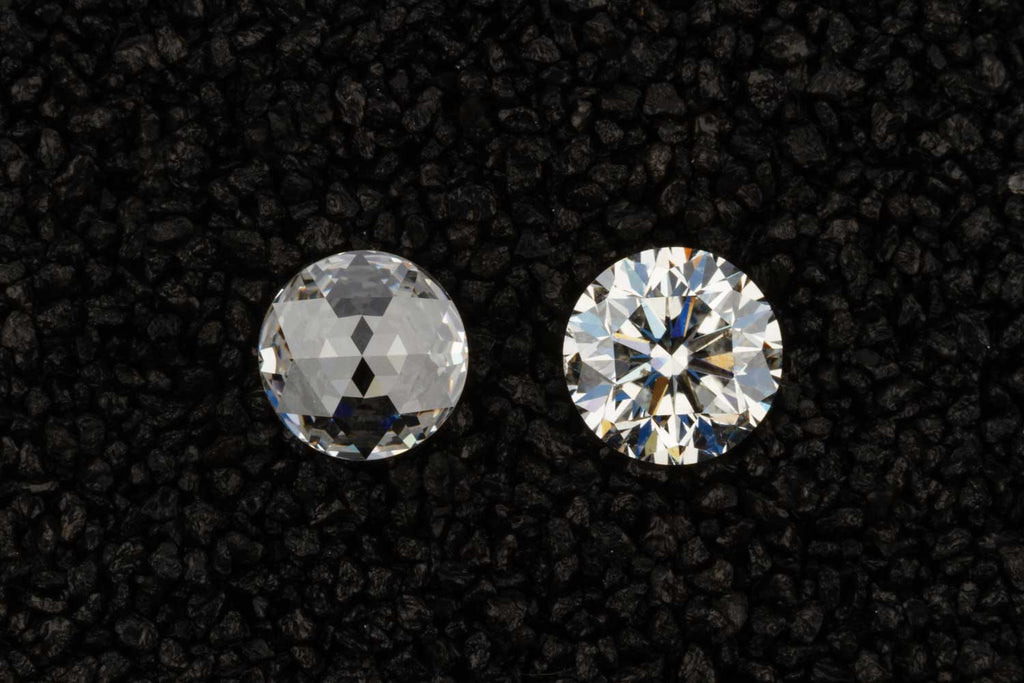The rising popularity of using antique cut diamonds in modern jewelry is no surprise. Antique diamonds offer a distinctive visual experience with how their hand-cut facets play with light, and lovers of the vintage inspired just can’t get enough of their warmth and sparkle.
Today, let’s get acquainted with a cut experiencing a huge resurgence in modern jewelry: The Rose Cut.
Rose Cut Diamonds
The most notable features of a rose cut diamond are their flat back and domed top covered in triangular facets. The number of these facets can vary from as few as 3 up to as many as 24, which terminate at the very top in a single apex. This is where the term “rose” from its name originates; It’s facets are said to resemble the petals unfolding in a rose bud.


The flat back of the rose cut has two noticeable effects. First, without any facets on the underside of the gem to reflect light, the gem is quite transparent. They have a calm and ethereal look to them compared to the disco-ball sparkle of full cut diamonds.
$4,710.00 $5,055.00Antique Diamond Engagement Rings
View All

.43ct Cosima Engagement Ring - Old European Cut Diamond with Canadian Diamond Accents in 14k Yellow Gold

.40ct Sierra Engagement Ring - Old European Cut Diamond with Canadian Diamond Accents in 14k Yellow Gold

Left: Rose cut Diamond. Right: Modern Brilliant Full Cut Diamond
Second, without any “junk in the trunk”, rose cuts carry all of their carat weight on top. This means that a rose cut diamond will appear to be a visually larger stone when viewed from above than a full cut diamond of the same carat weight. It will have a larger surface area since none of its carat weight is stored below the girdle.

Rose cut diamond top view

Rose cut diamond profile

Full cut diamond top view

Full cut diamond profile
Rose cuts are most commonly seen in the round, but can also be adapted into oval, pear, marquise and freeform shapes.
History of Rose Cut Diamonds
The rose cut originated in the 1500's and was commonly used through the Georgian and Victorian eras. Like other antique diamond cuts, they were cut by hand and meant to dazzle under candlelight. Their large, wide facets performed exquisitely in low light conditions.

An antique rose cut diamond. The girdle follows the shape of the original diamond crystal.
The shape of the rough diamond crystal influences the shape the diamond will be cut into. Diamond cutters seek to preserve as much of the original diamond carat weight as possible. In fact, if you get your hands on an antique rose cut, you’ll often notice that the perimeter follows the shape of the diamond crystal instead of being perfectly round. The shallow height of the rose cut diamond made great use of thinner crystals that weren’t deep enough for other shapes.
Color & Clarity
In the days of modern cutting, the whitest colored rough is usually cut into brilliant shapes that will fetch a higher price tag. But the icy sparkle we associate with today’s modern diamonds isn’t necessary for rose cut diamonds. Their cutting style lends itself to gems with warmer body color.
The clarity of your rose cut diamond is important because of the cut’s transparency. Since they have few facets to distract from internal flaws, small inclusions, and feathers within the crystal will be more visible. Opting for a diamond with pleasing clarity rather than a higher color grade will have a more noticeable impact on its beauty.

Rose cut opaque diamonds. Photo courtesy of Rough Diamond World.
Colored Rose Cut Diamonds
As the white rose cut diamond grew in popularity, the colored diamond followed suit. Rose cuts are now incredibly common in black, champagne and even opaque and rustic colors as well. But these rustic colored diamonds are not to be confused with "raw" diamonds since they have been cut and polished.
Diamond cutters often take lots of liberty when cutting opaque and rustic colored diamonds. Again, they prefer to follow the shape of the diamond crystal to preserve carat weight. You can find them in traditional rounds and ovals, but also in more creative shapes such as kites, hexagons and more.
Read more about rustic diamonds in my article here.

Rose cut sapphires
Rose Cut Gemstones
Colored gems in rose cut shapes have taken off in popularity as well. Rubies and sapphires can often be found as well as tourmaline, moonstone, and a variety of other semiprecious gems.
More saturated (and therefore more valuable) gemstone rough is usually preserved for faceted cuts that will result in a higher price tag. So similar to diamonds, the gemstone rough with the most desirable color is usually reserved for full cut gemstones. This means that our rose cut gemstones are often cut from lighter colored or more included gems. The result? A rainbow of pastel colors which are stunning in their own right.
All white diamonds featured in this article were generously loaned by Perpetuum Jewels.



